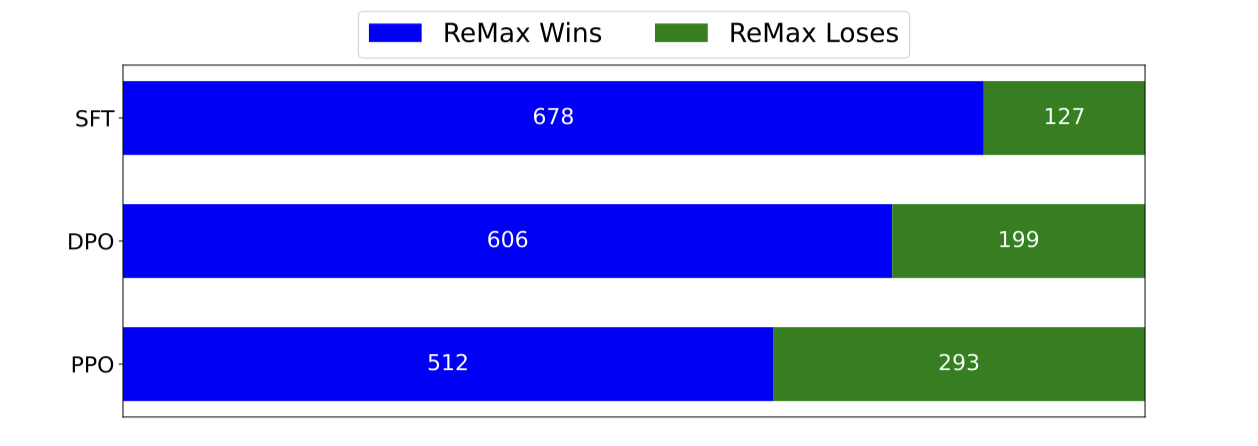ReMax is a reinforcement learning method, tailored for reward maximization in RLHF.
ReMax is easy to implement (with 6 lines of code). We provide an implementation based on the DeepSpeed framework in this resposity.
ReMax is memory-efficient. Compared with PPO, ReMax can save about 50% GPU memory consumption, which could be allocated for 1.3x large batch size.
Results of tuning Llama2-7B with A100-80GB GPUs
| GPUs | Offload | Method | Maximum Batch Size |
|---|---|---|---|
| 4 | False | PPO | ❌ (OOM) |
| 4 | False | ReMax | 4x26=104 |
| 4 | True | PPO | 4x30=120 |
| 4 | True | ReMax | 4x40=160 |
| 1 | True | PPO | 1x32=32 |
| 1 | True | ReMax | 1x42=42 |
*: Gradient checkpointing and ZeRO-2 are used for LLM.
*: ZeRO-3 and offload are used for the reward model and the reference model.
ReMax runs fast. It does not need to train a value model and requires fewer computations. Usually, it can achieve about 2x training speed-up.
Results of tuning Llama2-7B with A100-80GB GPUs
| GPUs | Offload | Method | Total Training Time |
|---|---|---|---|
| 4 | False | PPO | ❌ (OOM) |
| 4 | False | ReMax | 2.4h |
| 4 | True | PPO | 6.0h |
| 4 | True | ReMax | 2.8h |
| 1 | True | PPO | 22.0h |
| 1 | True | ReMax | 10.2h |
*: Gradient checkpointing and ZeRO-2 are used for LLM.
*: ZeRO-3 and offload are used for the reward model and the reference model.
*: Measurement is based on 45k training samples (with 1 epoch) from the full-hh-rlhf dataset.
ReMax is easy to tune for good performance. On the AlpacaEval benchmark, when judeged by GPT-4, ReMax achieves win rates of 84.22%, 75.28%, and 63.60% over SFT, DPO, and PPO, respectively.
- [2023-12-16] Add response samples of trained models and evaluation results of training speed.
- [2023-10-18] Release the initial code.
The Python environment can be set up using Anaconda with the provided environment.yml file.
conda env create -f environment.yml
conda activate llm
cd step1_supervised_finetuning
# OPT(1.3B)
bash training_scripts/opt/run_opt_1.3b.sh
# Llama2(7B)
bash training_scripts/llama2/run_llama2_1.3b.sh
cd step2_reward_model_finetuning
# OPT(1.3B)
bash training_scripts/opt/run_opt_1.3b.sh
# Llama2(7B)
bash training_scripts/llama2/run_llama2_1.3b.sh
cd step3_rlhf_finetuning
# OPT(1.3B)
bash training_scripts/opt/run_opt_1.3b.sh
# Llama2(7B)
bash training_scripts/llama2/run_llama2_1.3b.sh
Our code is heavily based on the DeepSpeed-Chat. Please follow the detailed instructions from DeepSpeed-Chat.
If you find this code is helpful, please cite our paper in the following format.
@article{li2023remax,
title = {ReMax: A Simple, Effective, and Efficient Method for Aligning Large Language Models},
author = {Li, Ziniu and Xu, Tian and Zhang, Yushun and Yu, Yang and Sun, RUoyu and Luo, Zhi-Quan},
booktitle = {arXiv preprint arXiv:2310.10505},
year = {2023},
}


